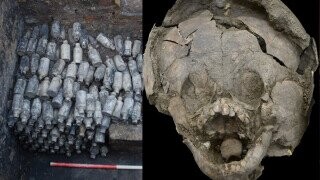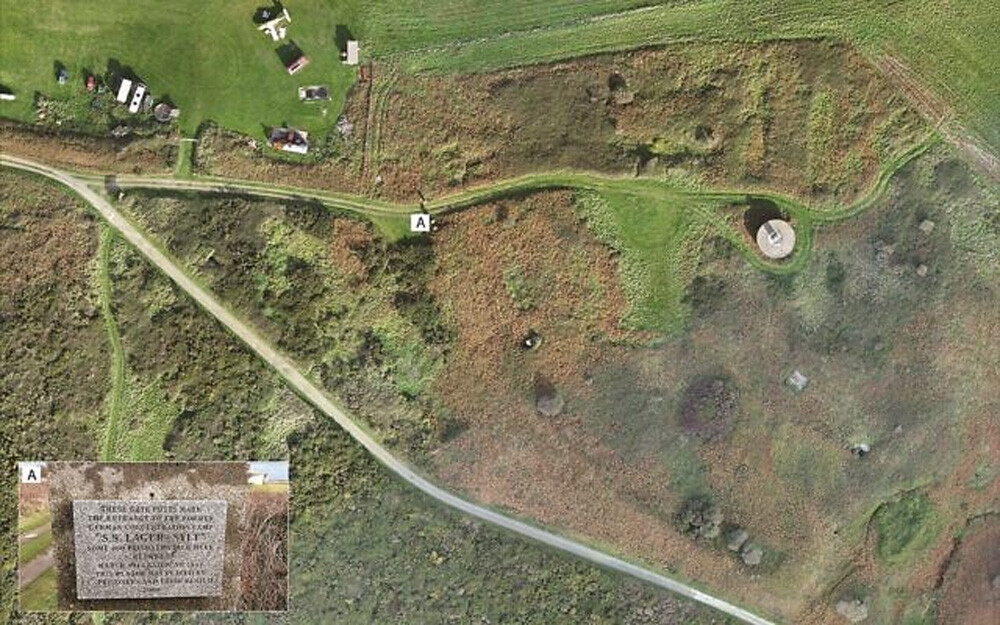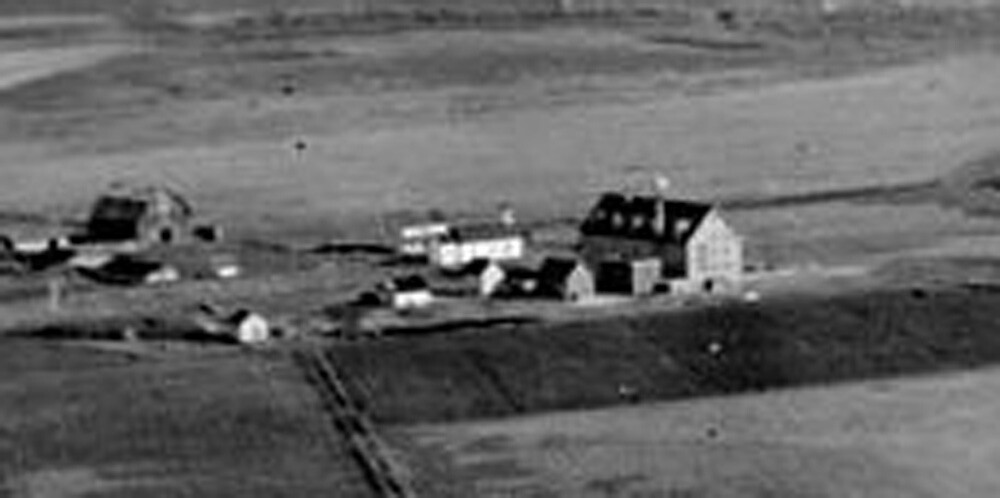5 Discoveries That Archaeologists Wish They Never Found

Let's be honest: Archaeology consists mostly of digging up pottery, which isn't that interesting unless an evil spirit is trapped inside. But it also involves finding all kinds of terrifying stuff. Stuff like the following, which, full disclosure, may involve more than a few evil spirits, of an entirely non-supernatural kind.
A Forgotten Nazi Concentration Camp ... Located In Britain
The Nazis occupied a piece of Britain during World War II. That sounds like a fact you'd have heard before now if it's true, but it's something everyone in Britain tried to forget ever happened. We're talking about the island of Alderney, located in the English Channel. Britain evacuated all its 1,500-odd residents in 1940, letting Germany take over this patch of British soil with zero effort.

Germany moved thousands of prisoners into concentration camps here. After the war, everyone was curious about what exactly went down in Alderney, so the UK released some info ... which, it turned out wasn't accurate at all and purposely understated all the horrible stuff. So, we can't trust British records to tell us the truth, and we sure can't trust Nazi records to tell us the truth. That's why we need archaeologists, who sometimes piece together stories from millennia ago but other times study stuff from just a few decades back.
In 2020, archaeologists investigated Sylt, the worst of the camps. They used their findings to verify various conflicting accounts, and they concluded that, yeah, the camp was really really bad. We're not going to get into all the details today, but prisoners were overcrowded, starved, beaten to death, and dumped in mass graves. It's, uh, kind of what you expect from death camps—especially ones kept secret by British government for ages.
Hundreds Of Toxic Beer Bottles
What do you get when you cross Victorian-era alcoholism and 19th-century plumbing? A liquid death trap hiding out in an abandoned cellar for well over a century now. Archeologists discovered 600 beer bottles last year in the cellar of an old Leeds brewery, and you really don't want to play pong with this stuff. These bottles are loaded with ridiculously high lead concentrations, each with enough lead to kill a fully grown adult.

Archaeological Services WYAS
So where did these creepy mysterious death bottles come from? What seems like an assassination method from Hitman or Skyrim actually has a simple explanation. See, Victorian people really liked pipes made of lead, so that's the sort of plumbing that poured out the water used to make the beer. Thus, the spooky lead beer.
We tend to forget that at some point, human beings weren’t the best at making beverages and food, which led to the notoriously unsafe conditions that cropped up around that time. Lead poisoning has a long history and, hell, is even still going on today, so if it turns out this beer killed people, we wouldn’t exactly faint from shock. We'd just faint from lead poisoning, because we forgot what was happening and absently drank a bottle of the stuff.
A Tunnel Of Death From World War 1
Besides being a major time when the world collectively went “shit just got real,” World War I had a casualty count of 40 million, making it the second-deadliest war of all time. Human beings have gotten pretty creative at finding ways to kill each other, and while we are all familiar with WW1’s atrocities, there’s still plenty to uncover.
In March of this year, excavations uncovered a tunnel filled with the bodies of 270 German soldiers. This discovery was made in a dig site near Reims, France, and comes complete with corpses and a host of other wartime items, like unexploded shells, axes, rifles, and more, much of it already looted by grave robbers.
The tunnel dates back to 1917, when the Germans fought the French to defend some hillsides. A trench shaft in the mountains held an entire regiment, whose fates were sealed as the tunnel collapsed in on itself after a mortar shell impact. From that point, all they could do was wait until their oxygen ran out, or commit suicide.
The Winterburg tunnel had been sealed for over 100 years, with nobody knowing the ultimate fate of the soldiers within. People with claustrophobia are probably clutching their hearts while reading this, and we can’t blame them. The tunnel will serve as a testament both to the cold indifference to human life that war brings, and also the very really possibility that you yourself will be buried alive suddenly and without warning, possibly within the next few minutes.
Remains Of Over 1,000 Indigenous Children In Canadian Residential Schools
This is one story we hope you've already heard about. But for anyone who hasn't, let's explain to you what Canadian residential schools were, as simply as we can. The Canadian Indian residential school system was basically the government-sanctioned theft of indigenous children, who were forced into boarding schools for assimilation and re-education. They ran from 1894 to 1947, and many native families never got any reparations or closure.
The legacy of residential schools resurfaced painfully when earlier this year, hundreds of indigenous children’s graves cropped up at former residential schools, such as the Kuper Island Industrial School. If that wasn't infuriating enough, well, it’s estimated that over 6,000 children died at various residential schools over time, and these ones might just be a small drop in the bucket. Many indigenous children at residential schools were subject to all kinds of pretty bad abuse, and viral infections like measles tore through them.

As expected, following the graves' discovery, the Canadian government immediately went on damage control mode—like all terrible governments inevitably do when confronted with their racist history. Trudeau called the stuff the school did shameful. Uh, okay Justin, thanks for that. Now if only Canada could do something actually impactful, like working towards lessening the number of indigenous people that go missing every year.
Ancient Child Helmets Made From Other Children’s Skulls
Sometimes we humans do pretty gnarly things to each other, and the layers of the earth are kind of like the rivers that mafia hit men throw bodies and guns into to hide the evidence. Buried deep in the ground are some of the worst atrocities human beings have ever committed.
Ecuadorian archeologists at a dig site in Salango unearthed something quite bone-chilling in 2019. Among the 2,100-year-old skeletons of the Guangala people, crammed into burial mounds, they found the remains of infants wearing helmets made entirely of the bones of other children. Like all things, the skull helmets had layers to them, as they were made of many different parts of child skulls, all assembled into wickedly nasty bone headwear made exclusively for presumably alive children to have.
These were two infants, aged nine months and 18 months, and the helmets were from children who were between four and 12 years old when they died. Researchers say the helmets were to protect infants from damage, perhaps from some kind of fall or battle, and that the unlucky children used to make the skulls might’ve been part of a sacrificial ritual. It’s pretty sinister to think about. This practice was extremely brutal, and also not very strategic. Adult skulls make for much better helmets; everyone knows that.
Top image: Archaeological Services WYAS, Sara Juengst/UNC Charlotte
